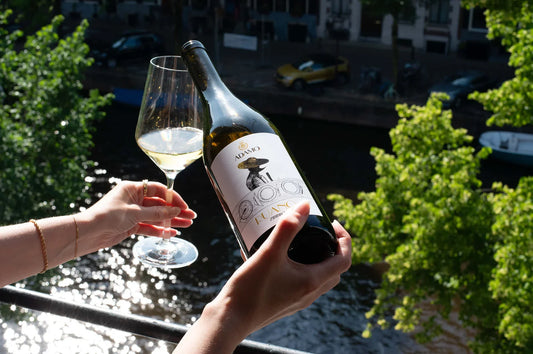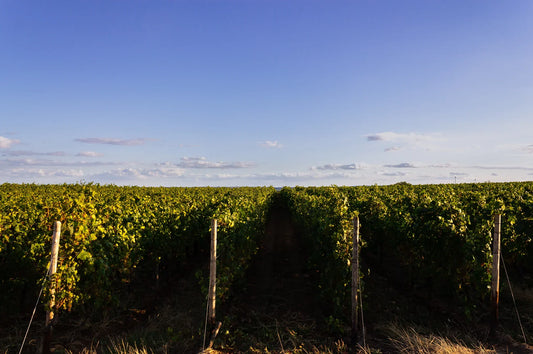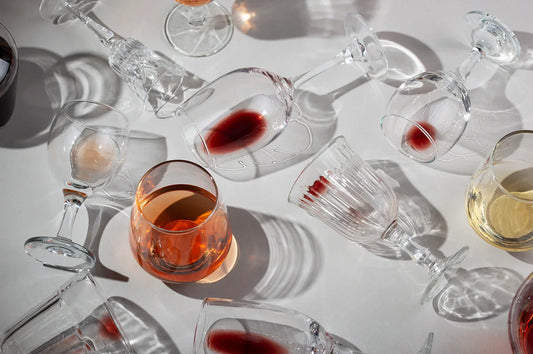Oxygen is an open wine bottle’s greatest enemy. Once a bottle is uncorked, the oxidation process begins—the same process that makes an apple turn brown—slowly altering the taste profile and bouquet and ultimately leading to a dull, lifeless wine. The goal, then, is to slow this process and preserve the wine's flavour for as long as possible.
Recognising Wine's Enemies
In addition to oxidation, big variations in temperature and light exposure rank highly amongst wine's adversaries, each able to diminish a wine's vibrancy and complexity.
As a result, sealing bottles tightly, keeping them cool, and shielding them from light are paramount in keeping wine fresh for as long as possible..
Oxygen's Effect on Wine
Upon exposure to air, wine begins a transformation, which both evolves and erodes its profile. In the absence of oxygen, wine would effectively be in stasis, indefinitely pausing the ageing process. However, once opened, oxygen interacts with the compounds in the wine, causing chemical reactions that lead to a loss of freshness, vibrancy, and complexity.
Temperature Swings and Their Impact
Fluctuations in temperature can exacerbate the oxidation process, degrading the wine’s balance and complexity, and sudden temperature changes cause the liquid in the bottle to expand and contract, potentially drawing in more air through the seal.
Moreover, warmth accelerates the chemical reactions within an opened bottle, diminishing the bouquet and palate .
Ideally, wines should be stored at their respective serving temperatures—whites chilled, reds slightly cool—to ensure the maintenance of their profile and longevity. But the primary aim is to shield opened bottles from temperature's whims and keep the wine stable ideally below but no higher than room temperature.
Light and Wine's Delicate Balance
Exposure to light, particularly UV, can precipitously degrade an opened wine's quality.
- UV Rays: These hasten the oxidation and ageing process, harming the wine's structure and flavour.
- Fluorescent Lighting: Common in many kitchens, fluorescent lights can emit enough UV light to negatively impact wine.
- Direct Light: Direct light is particularly dangerous. Exposure to direct sunlight or bright artificial light can cause the wine to deteriorate more quickly.
Sealing Strategies for Wine Longevity
Given proper storage is essential for preserving the freshness and flavour, here are 5 tips for keeping that opened bottle fresh:
- Store in a Cool and Dark Place: Keep opened wine bottles away from direct sunlight and high temperatures. Room temperature storage is generally ok for a day, but cooler is better.
- Avoid Temperature Fluctuations: Choose a location with a stable temperature. Your refrigerator can be ideal!
- Reseal the Bottle: Either reinsert the cork or use a wine stopper to reseal the bottle. You can also pour the wine into a mason jar or something similar that's smaller than the wine bottle, which will mean less air around the wine.
- Use a Vacuum Pump: For even more protection, remove excess oxygen from the bottle with a vacuum pump to preserve freshness.
- Invest in a Coravin: If you frequently find yourself opening a bottle and not finishing it, consider buying a Coravin, which allows you to pour wine without removing the cork!
Also, always remember most wines are best enjoyed within a few days of opening, even with good storage. So, the best wine storage tip of all is to finish it ;)
Optimal Cork Replacements
Once a bottle of wine has been opened, replacing the original cork with a specialized stopper can significantly extend its freshness.
- Vacuum Wine Stoppers: These devices extract air from the bottle, thereby minimizing oxidation.
- Silicone Wine Stoppers: A silicone wine stopper provides an excellent airtight seal. While it doesn’t remove the air in the bottle, it does a great of limiting additional air contact.
- Glass or Stainless Steel Wine Stoppers: Non-reactive materials such as glass or stainless steel also provide an effective barrier against oxidation, and often add an elegant touch.
- Inert Gas Wine Preservers: Instead of replacing the cork, these systems (like the Coravin) use gases like argon to protect wine from oxygen without affecting its taste. Rather than fully opening the bottle, the system uses a thin needle through the cork to pour wine while simultaneously replacing the wine with inert gas.
Positioning: How to Situate Your Wine
While wines being aged should rest on their side, once a bottle of wine is uncorked, we recommend keeping it upright to minimize the surface area exposed to oxygen, thereby reducing oxidation.
Post-Opening Shelf Life Guidelines for Different Wines
Light whites and rosés should be enjoyed promptly.
Consumption is recommended within two to three days for delicate white wines such as Pinot Grigio and Sauvignon Blanc, and similarly for most rosés. Their fresh, floral and fruity character is highly susceptible to decline, even under optimal preservation conditions—prompt consumption preserves their intended nuances.
Full-bodied whites have a moderate grace period.
While richer white wines like Chardonnay or Viognier exhibit a robust structure, their complexity is not immune to the effects of oxidation. A shelf life of three to five days post-opening, with proper refrigeration and airtight sealing, is advisable to maintain their rounded textures and layered bouquets.
Red wines tend to be a bit more resilient.
Full-bodied reds, particularly those with high tannin content like Cabernet Sauvignon or Syrah, can be savoured for up to five days, due to their tannins and complex structure acting as natural preservatives. However, lighter reds, such as Pinot Noir, are best consumed within three days.
Sparkling wines require extra care for freshness.
Sparkling wines have a shorter lifespan once opened due to their carbonation and delicate nature. To maintain their freshness and effervescence, it is recommended to consume sparkling wines within one to two days of opening. This is because the carbonation tends to quickly dissipate, resulting in a flat and, well, not sparkling, taste.
Fortified wines offer extended freshness and longevity.
Fortified wines, such as Port, Sherry, or Madeira can be enjoyed over a longer period compared to other types of wine. Fortified wines can stay fresh for several weeks or even months after opening, thanks to their higher alcohol content and the addition of spirits like brandy. However, it is still important to take care in storing them to help maintain the wine for as long as possible.
Conclusion
Properly storing opened wine bottles is crucial for maintaining their freshness and flavor. By recapping the bottle tightly, storing it in a cool and dark place, avoiding temperature fluctuations, and keeping it upright, you can extend the lifespan of your opened wine bottles for at least a little while longer.
And when you find you've drank everything and are in need of some more bottles, check out our somm-curated selections on Raravina.
Stay nosey!





